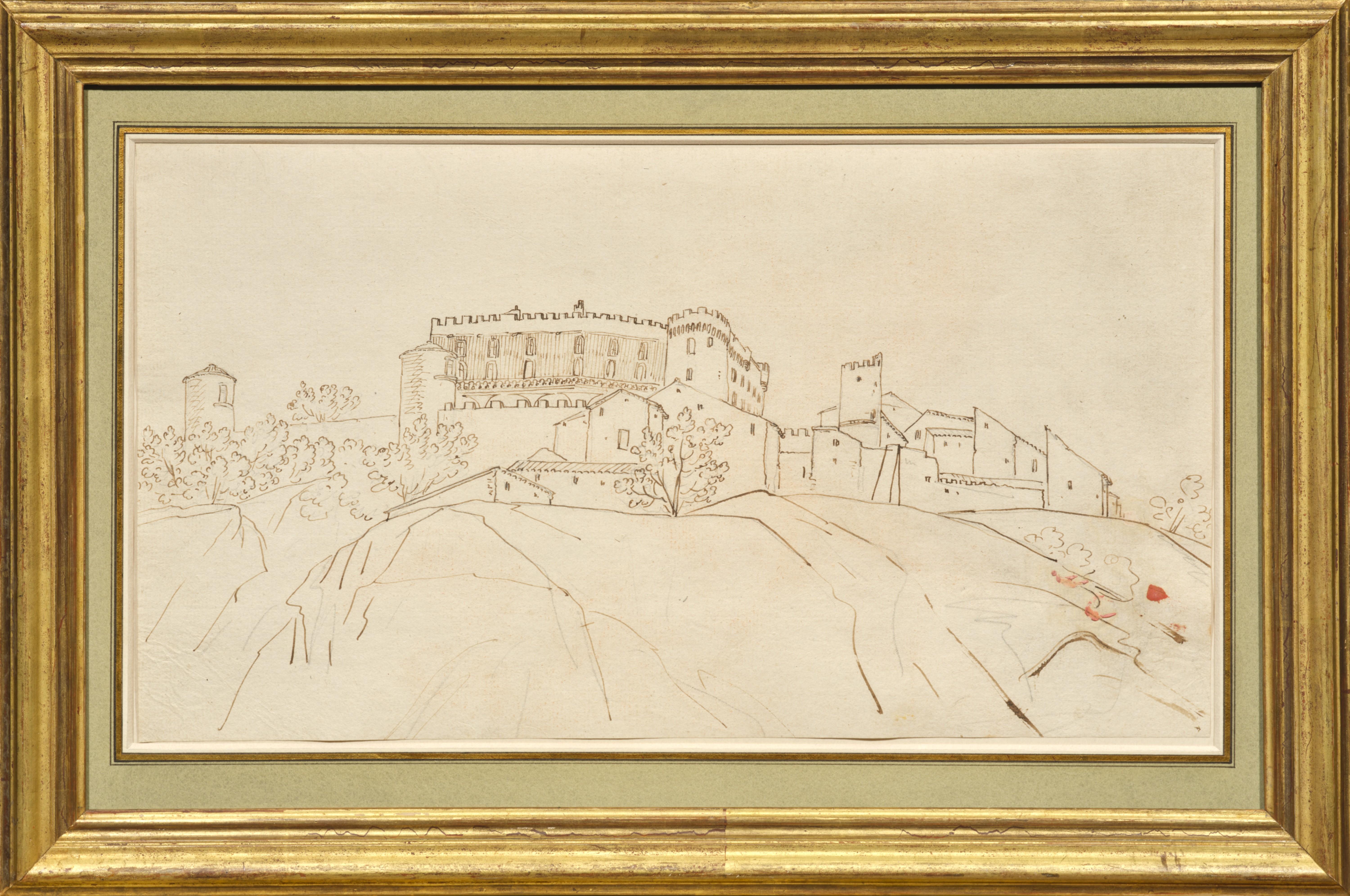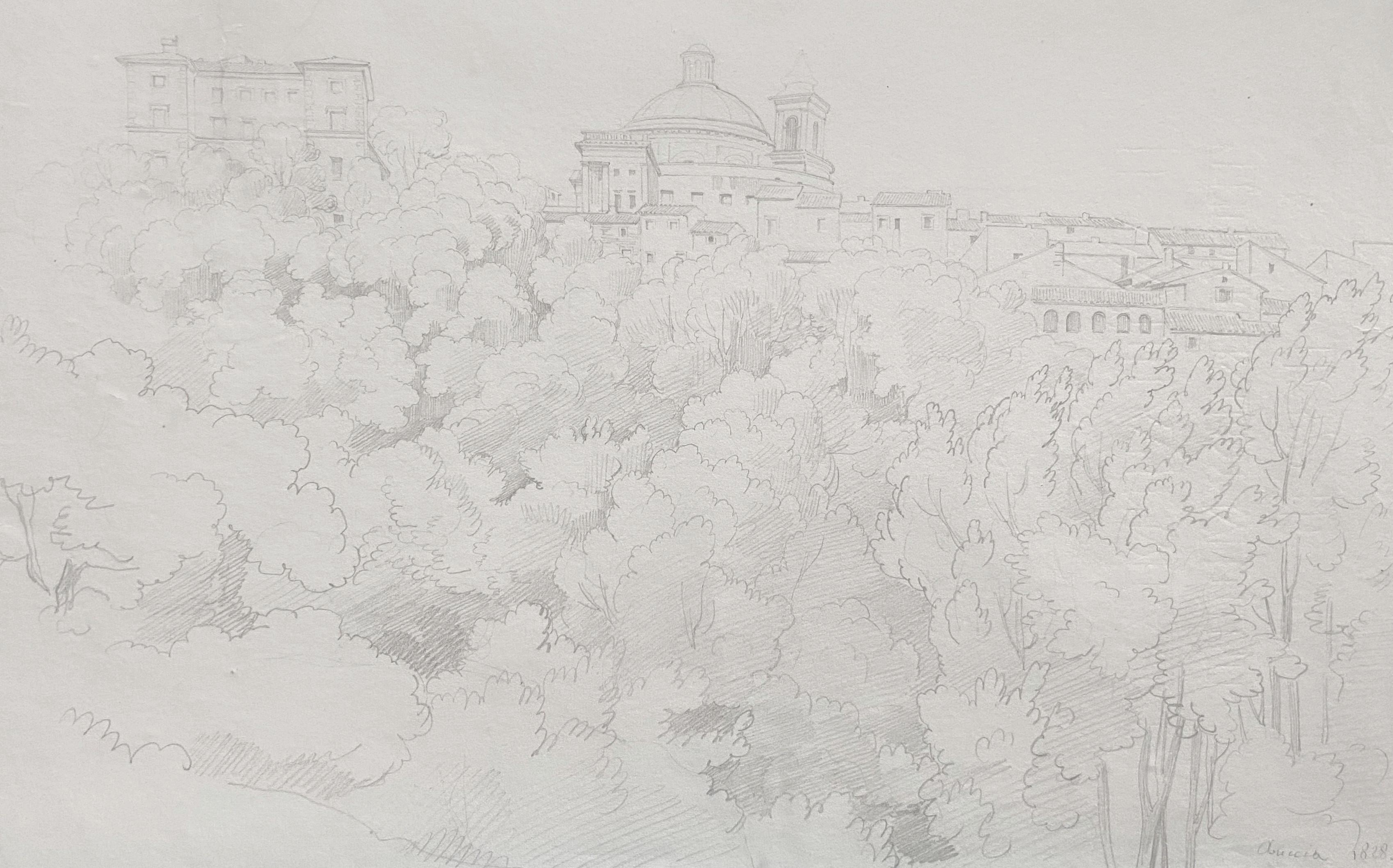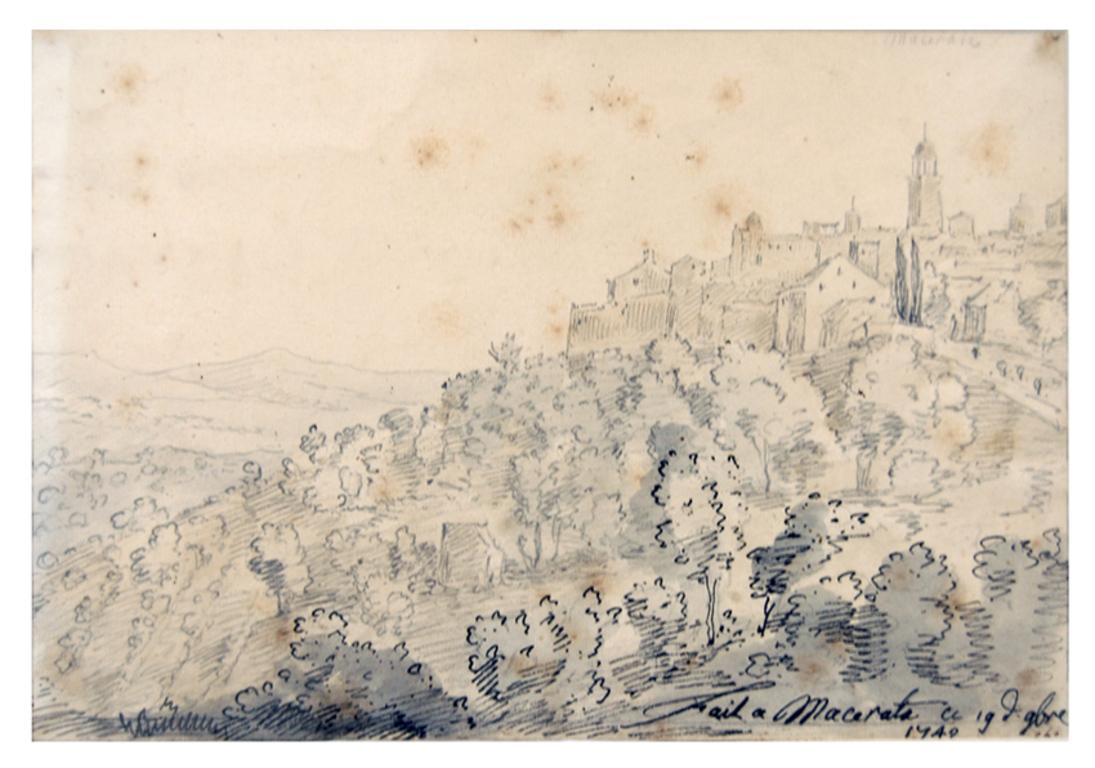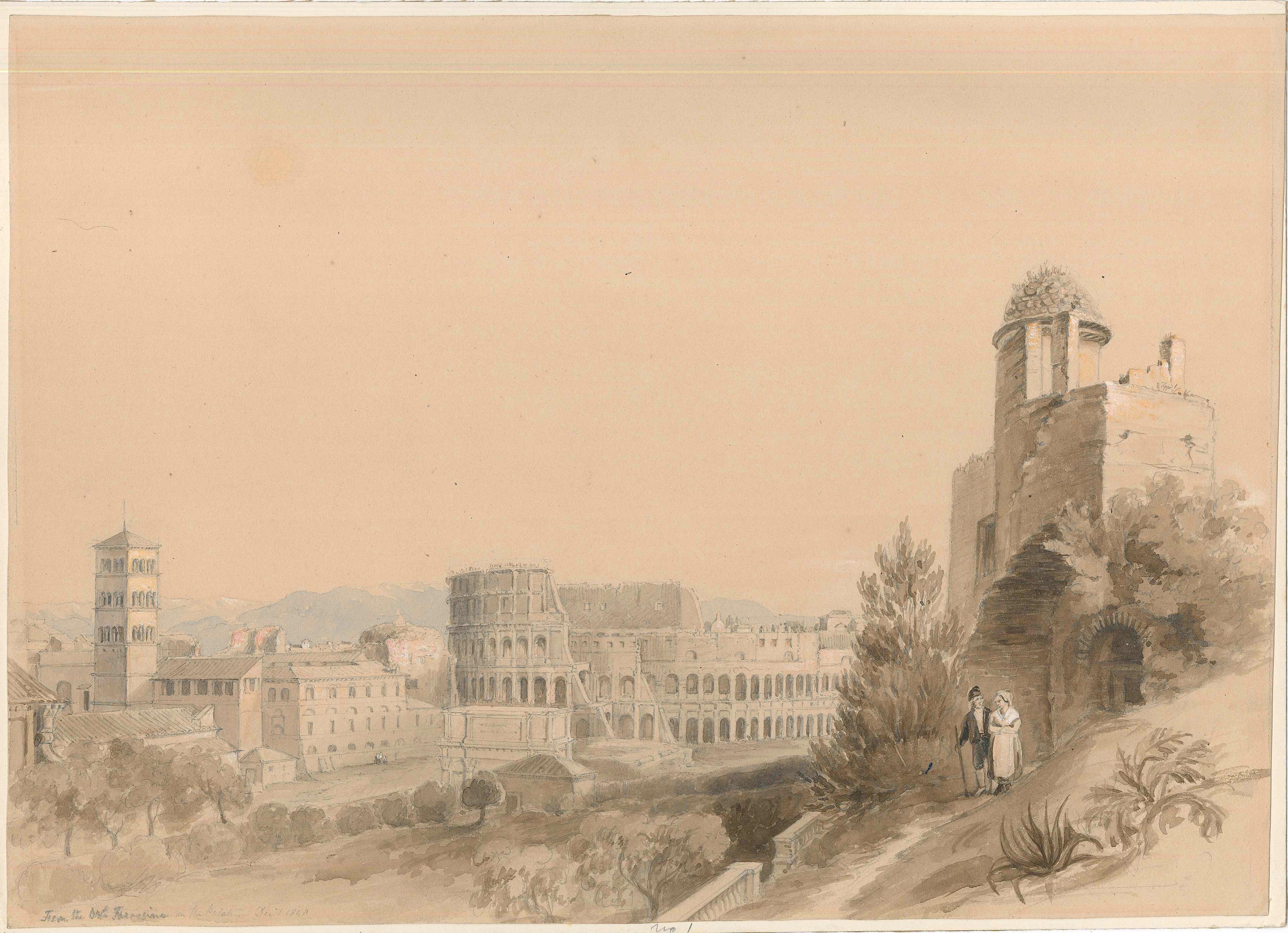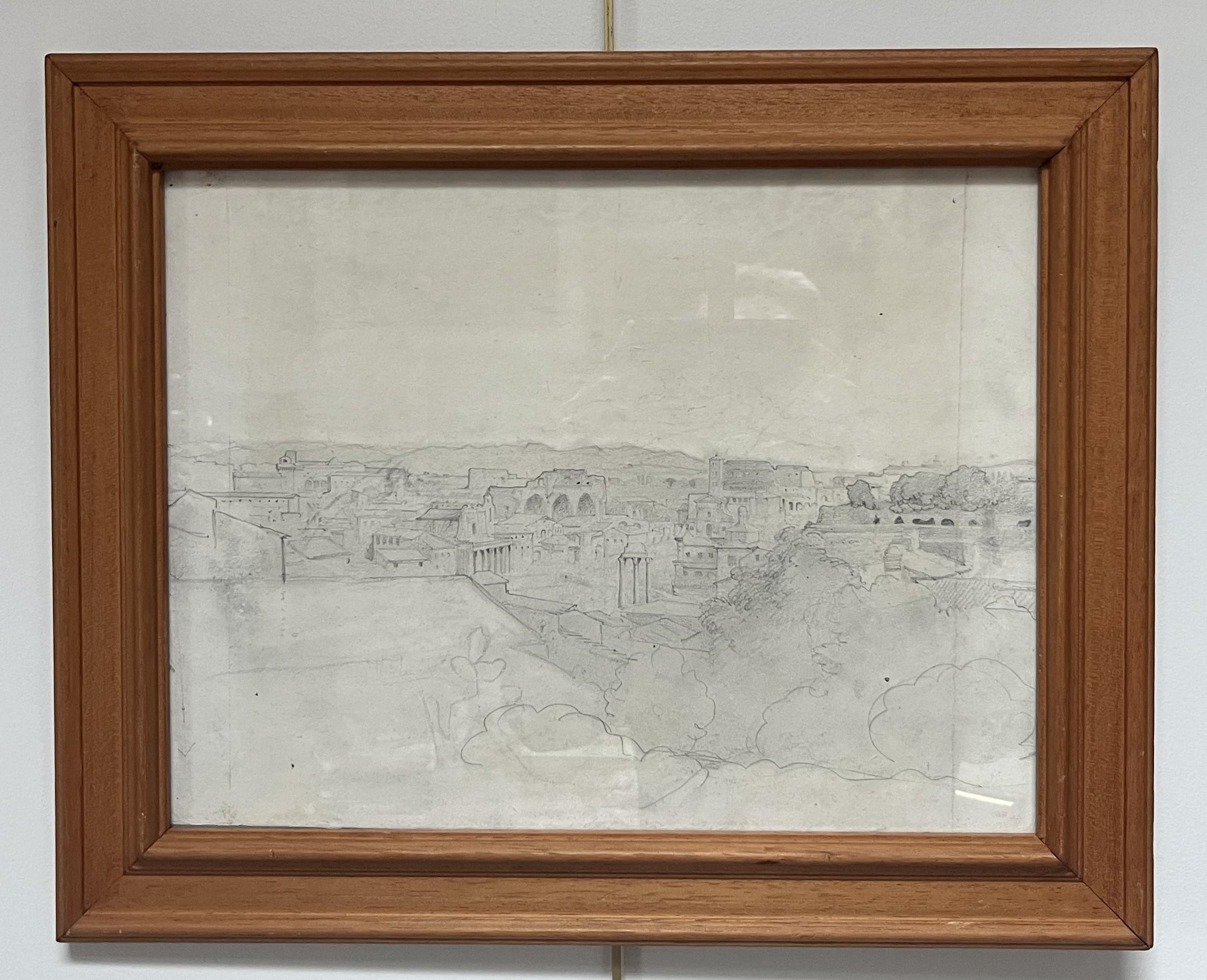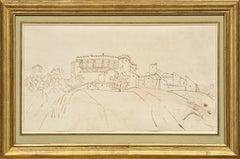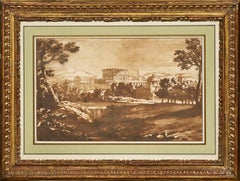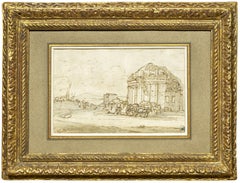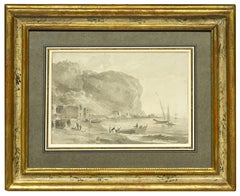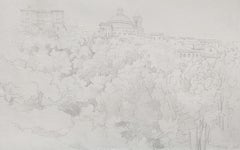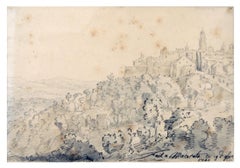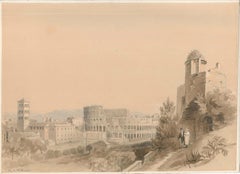Items Similar to View of Ariccia, a preparatory drawing by Achille Bénouville (1815 - 1891)
Want more images or videos?
Request additional images or videos from the seller
1 of 8
Jean-Achille BenouvilleView of Ariccia, a preparatory drawing by Achille Bénouville (1815 - 1891)1851
1851
$5,316.54
£3,985.07
€4,500
CA$7,304.02
A$8,154.25
CHF 4,272.70
MX$99,816.01
NOK 54,263.38
SEK 51,163.48
DKK 34,255.64
Shipping
Retrieving quote...The 1stDibs Promise:
Authenticity Guarantee,
Money-Back Guarantee,
24-Hour Cancellation
About the Item
This very modern drawing presents a view of Ariccia, a small town 25 kilometres south-east of Rome. The Palazzo Chigi (in which the film-maker Luchino Visconti would film a large part of The Leopard a century later) and the adjoining church are seen from the bottom of the ravine that surrounds the town. This drawing is a moving testimony to the attraction of the city for artists of the Romantic period, who established in Ariccia a vivid artists' colony.
1. Achille Bénouville, a French landscape painter in Italy
Achille Bénouville is probably the main representative of what could be defined as the third (and, so to speak, last) generation of neo-classical and/or historical landscape painters. Born in the 1810s and 1820s, Félix Lanoue, Paul Flandrin, Eugène Ferdinand Buttura or Alfred de Curzon are Bénouville’s contemporaries.
A pupil of François-Edouard Picot (1786 - 1868) and then of Léon Cogniet (1794 - 1880), Bénouville quickly specialised in landscape painting, starting with views of the Paris basin, which he exhibited at the 1834 Salon. He visited Italy three times, in 1838, 1840 and 1843. During his last trip in 1843, he became friends with Jean-Baptiste Corot (1796 - 1875) and shared his Roman studio.
After winning the historical landscape prize in 1845 (the same year his brother Léon won the Grand Prix de Rome for painting), he returned to Italy to spend three years at the Villa Medici. He then settled in Italy for 25 years, until the death of his wife in 1870, an event that led to his return to France.
2. Description of the artwork
From a viewpoint located below the town, the artist depicts the main monuments of Ariccia: the Chigi Palace and the adjoining church, the monumental access bridge.
The Chigi Palace was built between 1664 and 1672 by the Chigi family, which was at the height of its power thanks to the pontificate of Alexander VII (1655 - 1667). Carlo Fontana was the architect who supervised the transformation of an earlier fortress, based on a project by Giovan Lorenzo Bernini, who also designed the Maria Assunta Church opposite.
The small town, which stands on a hilltop, is surrounded by deep ravines, which explains the construction in the mid-19th century of the monumental access bridge one can see on the left.
This view taken from below shows the city in a backlight which the artist has rendered with great economy of means. The city stands out against a bluish sky suggested by a thin highlight of gouache. Only the shadows are drawn with a grey wash, while the rest of the ochre-coloured paper remains unpainted.
3. Related artworks
While some older drawings demonstrate that Bénouville visited Ariccia well before 1851, it seems to us that our drawing can be regarded as a preparatory drawing, probably executed in the open air, for the much more accomplished drawing from the Metropolitan Museum in New York (last image in the gallery). The latter was done in brown ink wash with watercolour highlights and bears the signature "Ach. Bénouville Roma 53", which clearly indicates that it was made at a later stage in the artist's Roman studio.
4. Ariccia, an artists' colony at the gates of Rome
The fame of Ariccia in the Romantic period was largely based on the attractiveness of the Locanda Martorelli, the inn located in the square in front of the palace, which was a popular stop on the road to Naples during the Grand Tour. This inn later became a holiday resort attracting the entire Romantic generation, both writers and painters. Artists as diverse as J.M. William Turner (1775 - 1851), Jean-Baptiste Corot (1796 - 1875) and Henrik Ibsen (1826 - 1906), who wrote his play Brand here in 1865, stayed there.
It is interesting in this respect to compare this drawing to the view of Ariccia painted in 1826-1827 by Jean-Baptiste Corot (with whom Bénouville shared a studio in Rome in 1843). In this painting Corot presents a viewpoint quite similar to that of our drawing, also in a backlight, at a time when the monumental access bridge had not yet been built.
5. Framing
The drawing has been given new margins and is presented in a 19th century natural wood frame with light fillets. The blue of the marie-louise has been chosen to match the thin gouache highlights of the sky.
Main bibliographical references :
Marie-Madeleine Aubrun Achille Benouville 1851-1891. Paris, 1986
- Creator:Jean-Achille Benouville (1815 - 1891, French)
- Creation Year:1851
- Dimensions:Height: 8.44 in (21.44 cm)Width: 11 in (27.94 cm)
- Medium:
- Movement & Style:
- Period:
- Condition:Grey ink wash and gouache over pencil lines Signed and dated lower left "Bénouville Ariccia 51” 8 7/16’’ x 11” (215 x 280 mm) – Framed : 14 5/16”x 16 7/8” (36.4 cm x 42.8 cm) Provenance: Ullmann collection (stamp) 19th century dark wood frame.
- Gallery Location:PARIS, FR
- Reference Number:1stDibs: LU1568210961182
About the Seller
5.0
Vetted Professional Seller
Every seller passes strict standards for authenticity and reliability
Established in 2020
1stDibs seller since 2021
10 sales on 1stDibs
Typical response time: 2 hours
- ShippingRetrieving quote...Shipping from: PARIS, France
- Return Policy
Authenticity Guarantee
In the unlikely event there’s an issue with an item’s authenticity, contact us within 1 year for a full refund. DetailsMoney-Back Guarantee
If your item is not as described, is damaged in transit, or does not arrive, contact us within 7 days for a full refund. Details24-Hour Cancellation
You have a 24-hour grace period in which to reconsider your purchase, with no questions asked.Vetted Professional Sellers
Our world-class sellers must adhere to strict standards for service and quality, maintaining the integrity of our listings.Price-Match Guarantee
If you find that a seller listed the same item for a lower price elsewhere, we’ll match it.Trusted Global Delivery
Our best-in-class carrier network provides specialized shipping options worldwide, including custom delivery.More From This Seller
View AllView of a Mansion in the South of France, a drawing by Claude-Joseph Vernet
By Claude-Joseph Vernet
Located in PARIS, FR
We would like to thank Madame Beck-Saiello for confirming the autograph nature of this drawing after an in-person examination.
It was probably during an excursion in the countryside near Avignon that Claude-Joseph Vernet executed this drawing, enhanced with pen and brown ink, depicting a mansion on a hilltop overlooking a small village with geometric shapes.
1. Joseph Vernet, a painter influenced by Italy
Claude-Joseph Vernet was born in Avignon in 1714, the son of Antoine Vernet (1689-1753), an artisan painter of architectural decorations, coach panels, and the like. He moved to the studio of Philippe Sauvan (1697-1792), a leading history painter in Avignon, and then worked with Jacques Viali (active 1681-1745), a decorative, landscape, and marine painter in Aix-en-Provence. Vernet's first recorded paintings were decorative overdoors executed in 1731 in the Aix townhouse of the marquise de Simiane. In 1734, Joseph de Seytres, marquis de Caumont, a leading amateur in Avignon, sponsored Vernet to make a study trip to Italy to complete his artistic education and to draw antiquities for his patron.
As Avignon was a papal territory in Vernet's day, he also had a number of useful introductions among influential churchmen when he arrived in Rome. Vernet was soon at home in the French community there, and he was encouraged by Nicolas Vleughels (1668-1737), director of the Académie de France in Rome, even though the young painter had no official affiliation with the royal institution. He likely entered the studio of the French marine painter Adrien Manglard...
Category
1730s Old Masters Landscape Drawings and Watercolors
Materials
Ink, Laid Paper, Pen, Carbon Pencil
View of an Antique City, a wash landscape by Jan de Bisschop (1628 - 1671)
Located in PARIS, FR
The attribution to Jan de Bisschop has been confirmed by the RKD with the following comment: "We base this attribution on the dark washes, the subject represented and the monogram".
...
Category
17th Century Old Masters Landscape Drawings and Watercolors
Materials
Ink, Pen
A landscape drawing by Claude Lorrain, with a preliminary sketch on the verso
By Claude Lorrain
Located in PARIS, FR
This study presents a typical Roman countryside landscape: an ancient mausoleum in front of which a cart is passing by followed by two peasants. If the technique (a pen drawing on graphite lines, completed with a wash of brown and grey inks) and the signature inevitably evoke the art of Lorrain, we find on the verso of this drawing additional evidences that lead us to consider this unpublished drawing as a work by the master.
The motif of the mausoleum has been taken up in pen on the verso in a technique that can be found in several other drawings by Lorrain. There is also a study of three characters, which can be considered as preparatory to Lorrain’s painting entitled The Port of Ostia with the Embarkation of Saint Paula, leading us to claim this attribution with a dating of around 1639.
1. Claude Lorrain or the perfection of classical landscape in Rome in the 17th century
Claude Gellée was born in 1600 in Chamagne in Lorraine. Orphaned at the age of twelve, he spent a year with his brother in Freiburg, where the latter was a woodcarver. Claude Gellée then probably arrived in Rome in 1613, where he joined the workshop of Agostino Tassi (1580 - 1644) in 1617. Between 1619 and 1620 he studied for two years in Naples in the workshop of Goffredi Wals (who was himself a former pupil of Tassi).
In 1625 he returned to Lorraine for two years where he worked alongside Claude Deruet. He then returned to Rome, a city he never left for the rest of his life (except for short trips to the surrounding countryside).
From 1627 to 1650 he lived in Via Margutta. From 1635 onwards he became a renowned painter and commissions started to pour in. Considered during his lifetime as the most accomplished of the classical landscape painters, his reputation never faded.
Between 1629 and 1635 Le Lorrain often went to the Roman countryside to draw with his friend Joachim von Sandrart (1606 - 1686). He became a member of the Academy of Saint Luke in 1633, while being closely acquainted with the Bentvueghels, this guild which brought together the young Nordic painters active in Rome. In 1643 he joined the Congregation of the Virtuosi. In 1650 he moved to Via Paolina where he lived until his death.
Little is known of his intimate life. He seems to have had a daughter, Agnes, from an ancillary love affair. In 1657/ 1658 she moved in with him. Stricken with gout in 1663, he died in 1682.
2. Description of the drawing; the technique of nature studies
Two peasants are walking behind a horse-drawn cart on a road that winds through ancient tombs. While a rectangular tomb with a columned facade can be seen in the distance, the cart passes an important ancient building. It has a circular shape and its partially ruined façade is decorated with columns. The start of a second floor can...
Category
1630s Old Masters Landscape Drawings and Watercolors
Materials
Pen, Graphite, Ink
View of the Posillipo coastline near Naples by William Marlow (1740 - 1813)
By William Marlow
Located in PARIS, FR
In this drawing, inspired by his stay in Naples in 1765, William Marlow presents us with a view of Cape Posillipo, to the west of Naples, an essential stage during the Grand Tour. Th...
Category
1760s Old Masters Landscape Drawings and Watercolors
Materials
Ink
View of the Ovo Castle in the Moonlight, a 19th century Neapolitan gouache
Located in PARIS, FR
Neapolitan gouaches appeared in the eighteenth century when tourism in the Naples area was developing: the discoveries of Herculaneum and Pompeii made this city a mandatory stop on the Grand Tour, the journey made by wealthy Europeans to complete their education.
Generally small in size for ease of transport and affordable in price, these gouaches were the ideal travel souvenir that these tourists of the early days were bringing back to capture the idyllic landscapes they had discovered during their journey and to share them with family and friends upon their return at home.
The Bay of Naples and the eruptions of Vesuvius are the favourite themes of these views. Here we have a view of the Ovo Castle, which was rebuilt on the island of Partenope, in the middle of the Bay of Naples and about a hundred metres from the shore by the Normans in the 12th century on antique ruins...
Category
Early 19th Century Romantic Landscape Drawings and Watercolors
Materials
Gouache, Paper
Rocky Landscape with Trees and Temple Ruins a drawing by Giulio Parigi (ca 1615)
Located in PARIS, FR
This Rocky Landscape with Trees and the Ruins of a Temple is a drawing by Giulio Parigi, an eclectic and prolific artist of the Medici court. An engraver, architect, furniture and je...
Category
1610s Old Masters Landscape Drawings and Watercolors
Materials
Ink, Laid Paper, Pen
You May Also Like
French Romantic School, View of Arriccia, 1828, drawing
Located in Paris, FR
French Romantic School beginning of the 19th Century
View of Arriccia, 1828
located and dated, "Arriccia 1828" on the lower right
Pencil on paper
23 x ...
Category
1820s Romantic Landscape Drawings and Watercolors
Materials
Pencil
$879 Sale Price
20% Off
Vue de Macerata et de sa Campagne - drawing by J. P. Verdussen - 1742
By Jan Peeter Verdussen
Located in Roma, IT
China ink and watercolour on paper.
Some foxing, otherwise very good condition.
Titled and dated.
Includes passepartout.
Category
1740s Figurative Drawings and Watercolors
Materials
Ink, Watercolor
View Of Rome - Watercolor on Paper by C.R. Cockerell - Mid 19th Century
By Charles Robert Cockerell
Located in Roma, IT
View Of Rome is a beautiful artwork realized by Charles Robert Cockerell in the XIX century.
Watercolor on paper. Inscribed in pencil on lower left and verso.
This charming artwork...
Category
Mid-19th Century Modern Landscape Drawings and Watercolors
Materials
Watercolor
View of Royat, Puy-de-Dôme, circa 1830
Located in Paris, FR
Painting, oil on paper pasted on panel, representing a view of the city of Royat, located in the department of Puy-de-Dôme.
Located in the western suburbs of Clermont-Ferrand, the c...
Category
1830s Italian School Landscape Paintings
Materials
Oil
$2,646 Sale Price
20% Off
Jean-Achille Benouville (1815-1891) Rome, View of the Forum, drawing
Located in Paris, FR
Jean-Achille Benouville (1815-1891)
Rome, View of the Forum,
pencil on paper
28.5 x 37.5 cm
framed 38.5 x 47.5 cm
This drawing is characteristic of Romantic artists who, like Coro...
Category
1860s Romantic Landscape Drawings and Watercolors
Materials
Carbon Pencil
View of Avellino - Etching by Tommaso Piroli - Mid-19th century
Located in Roma, IT
View of Avellino is a print realized by Tommaso Piroli in the mid-19th century.
Etching Hand-watercolored on paper.
Signed and titled on the plate.
Good conditions with foxing
Category
Mid-19th Century Contemporary Figurative Prints
Materials
Etching
More Ways To Browse
Framed Drawings
Large Landscape Drawing
1891 Painting
Pencil Drawing Church
J A Turner
Jean Baptiste Artist
The Antique Inn
Paintings Of Leopards
Antique Basin Stand
A Smaller Fortress
Grand Tour Watercolour
Antique Wash Basin
Gouache Naples
Luchino Visconti
Antique Church Gates
Neo Classical Painting Landscape
Antique Wash Stand Wood
Picot Painting
